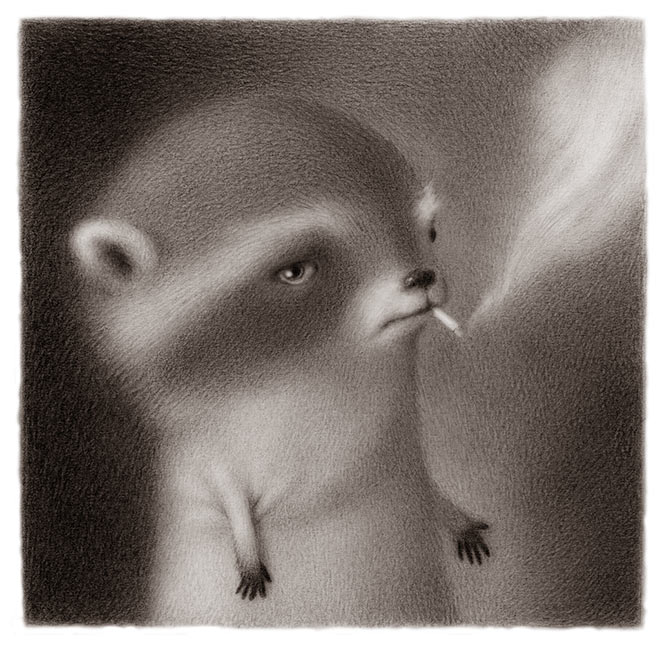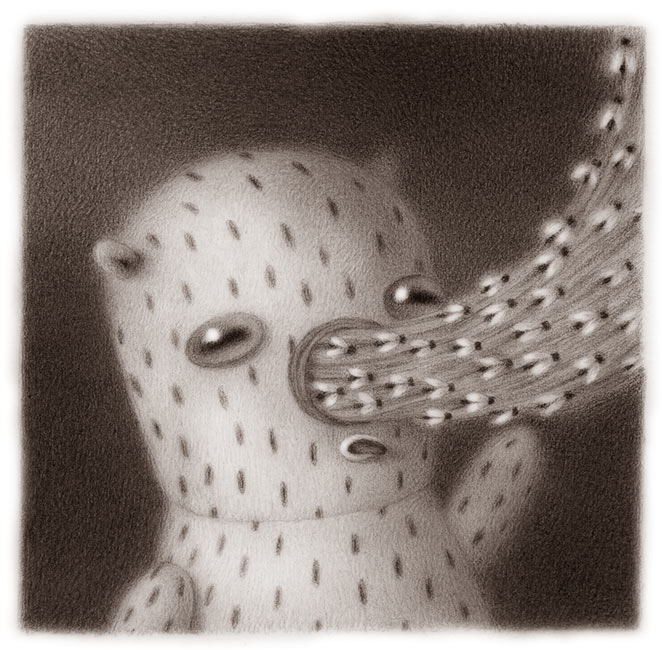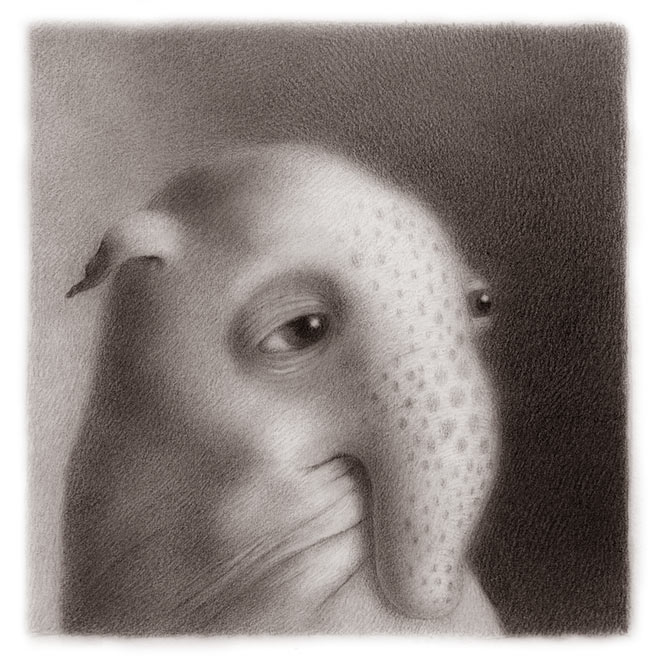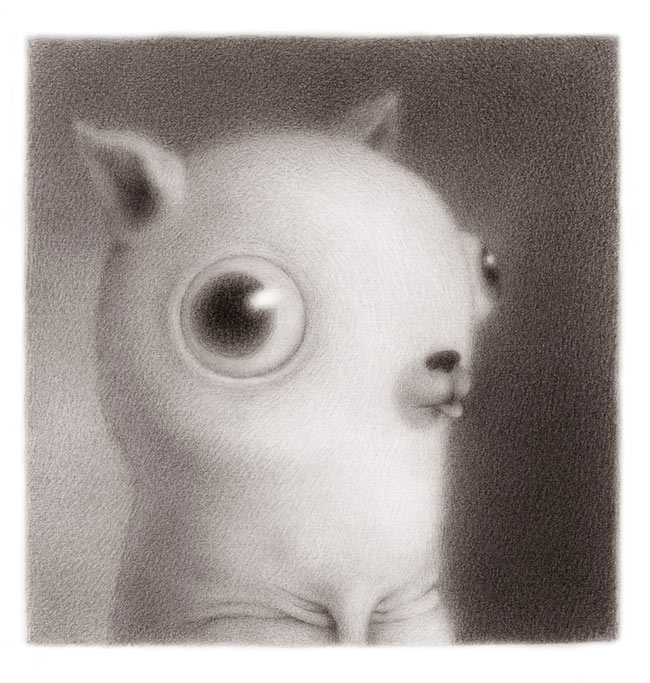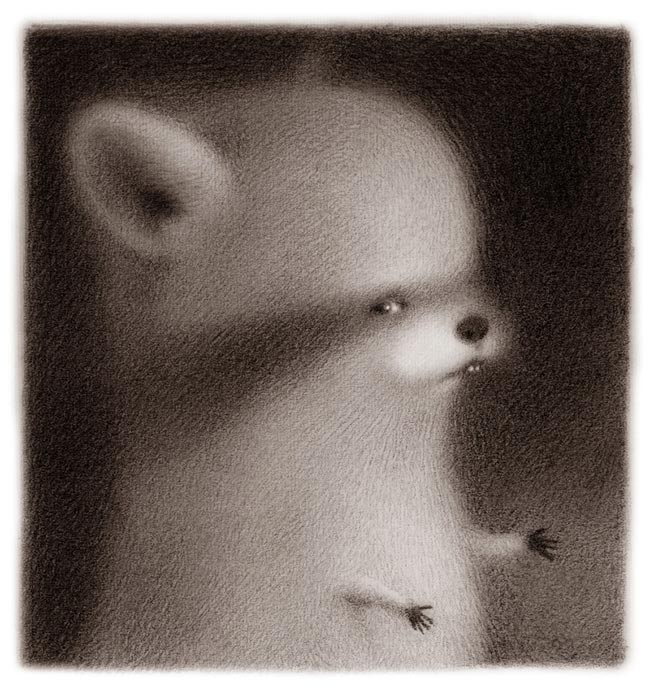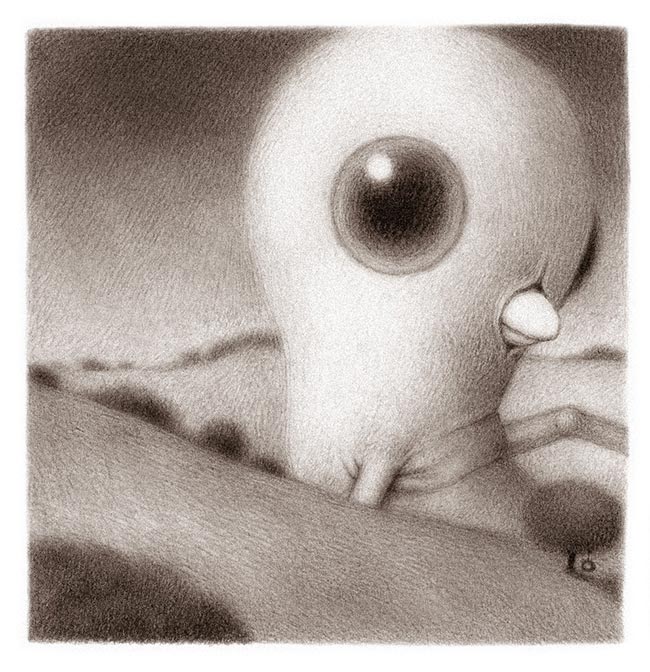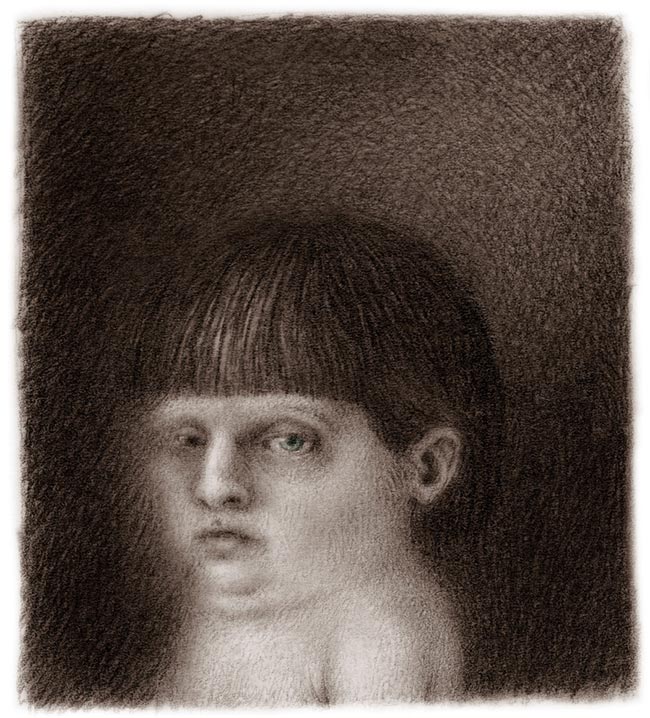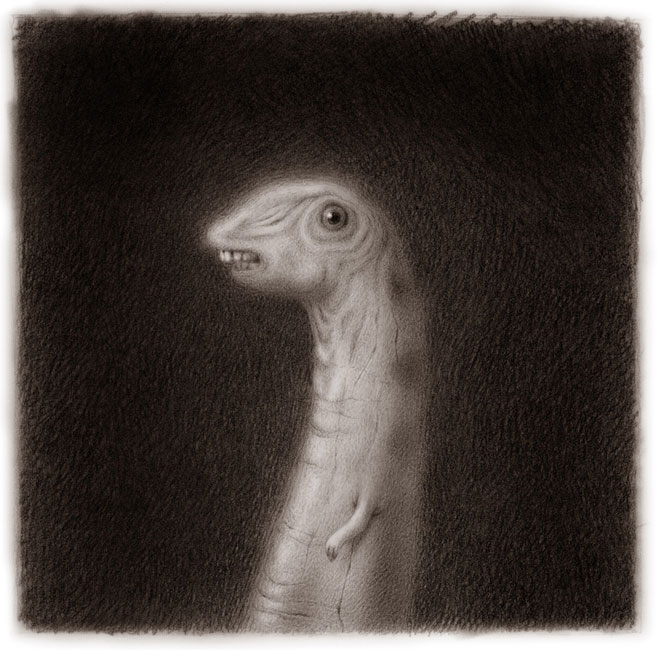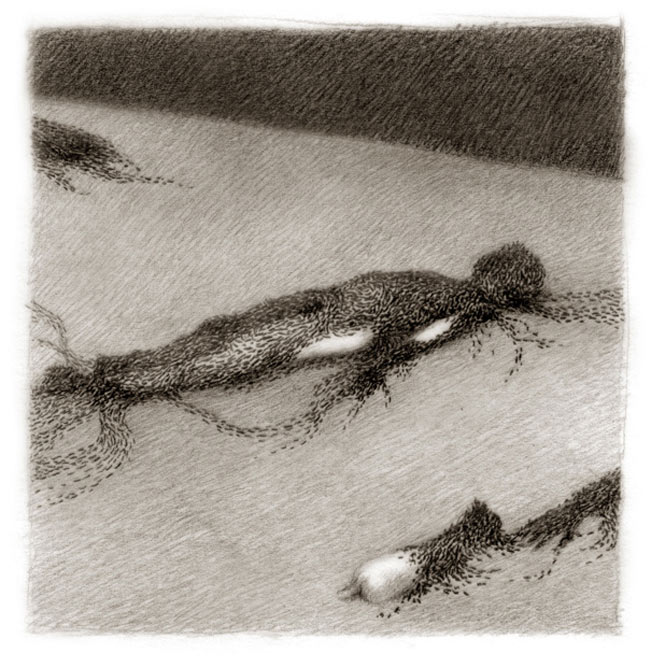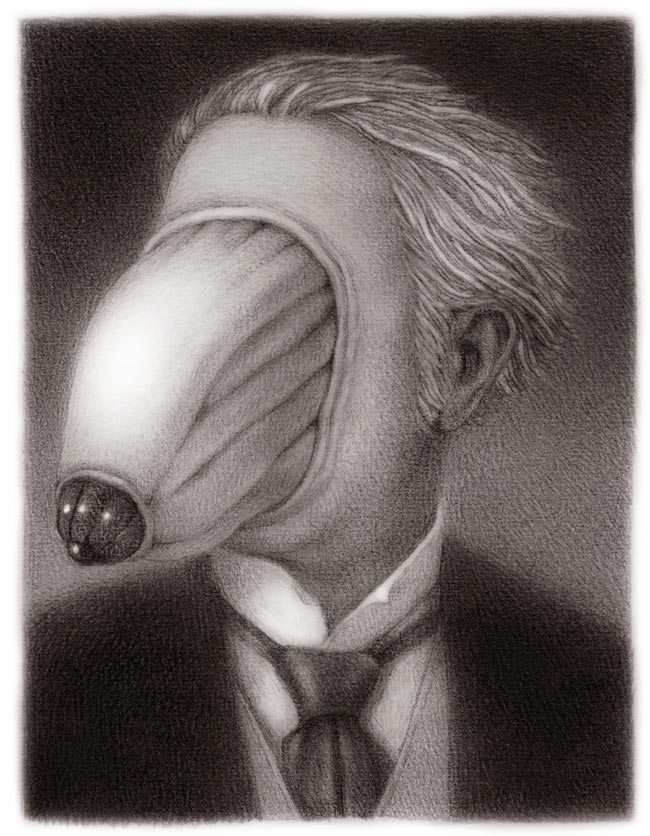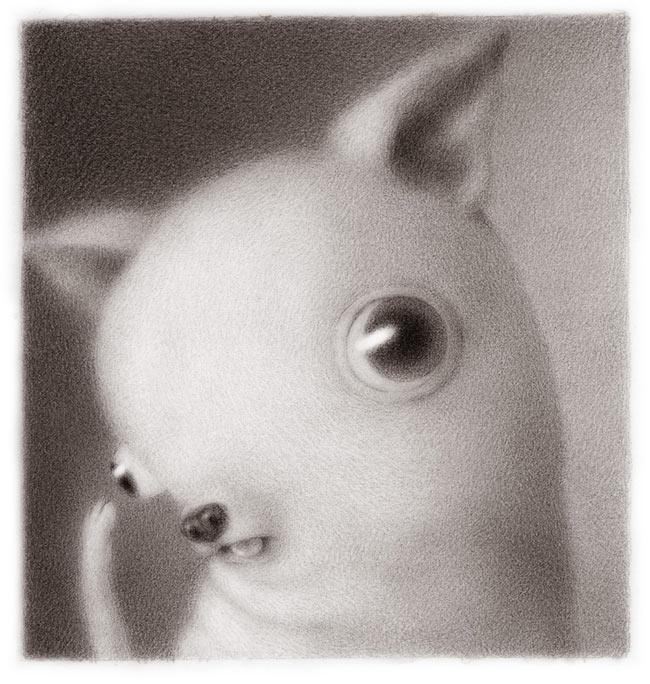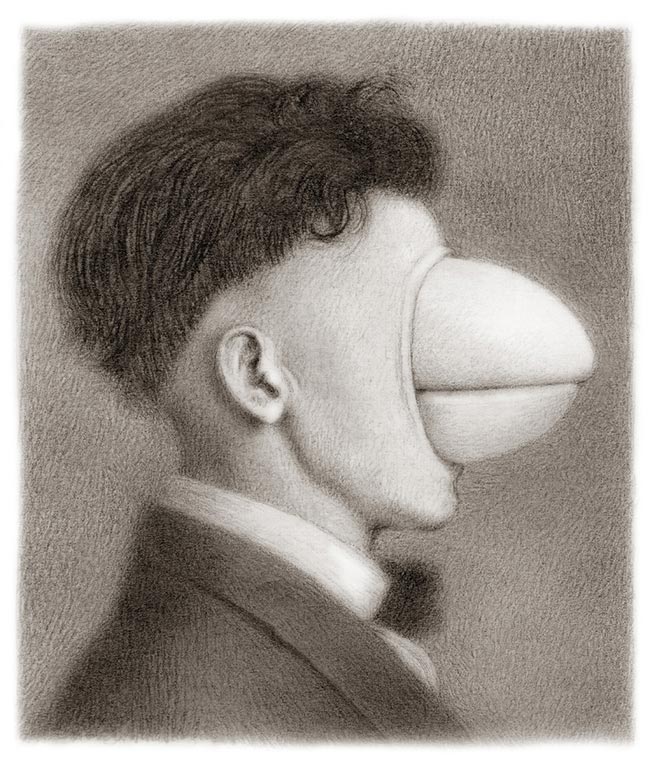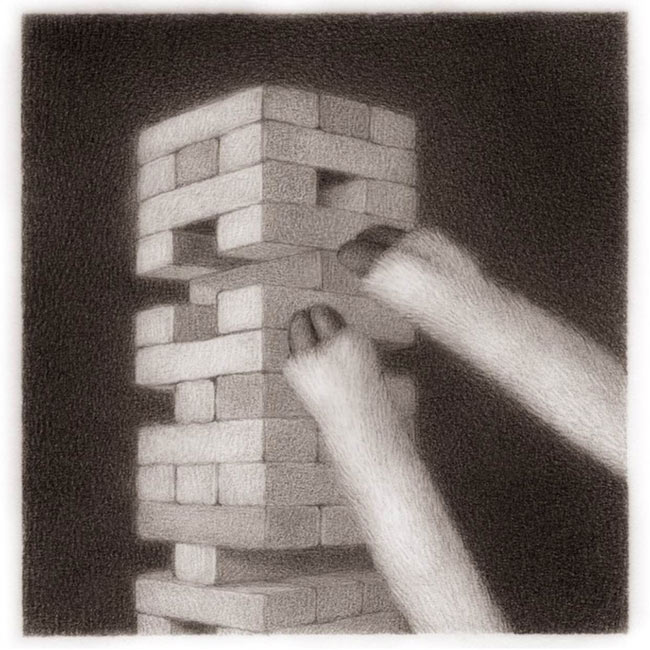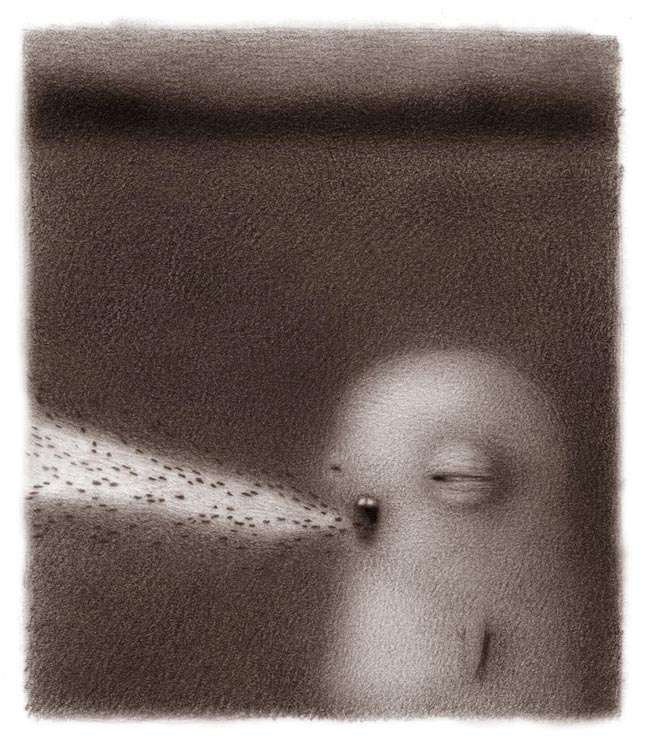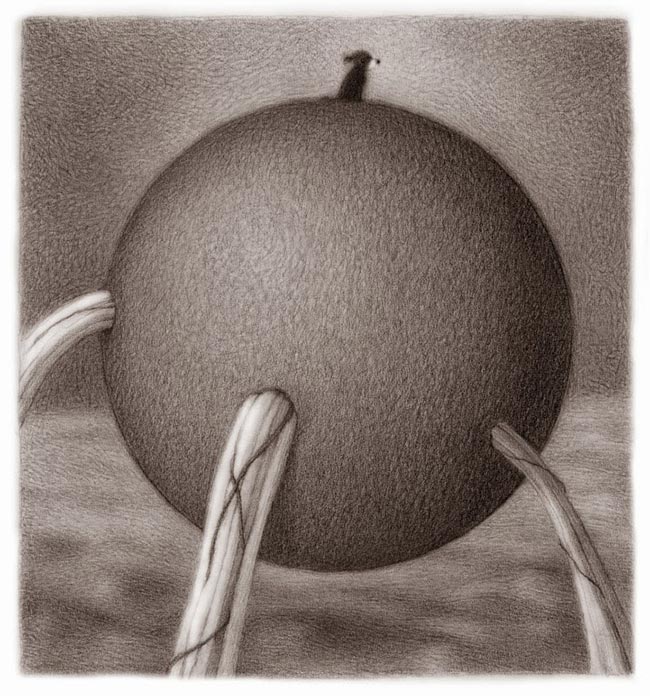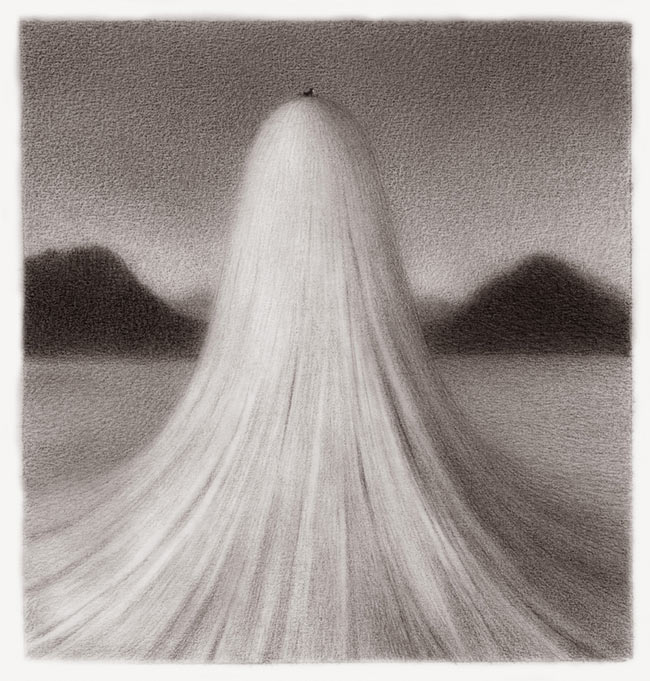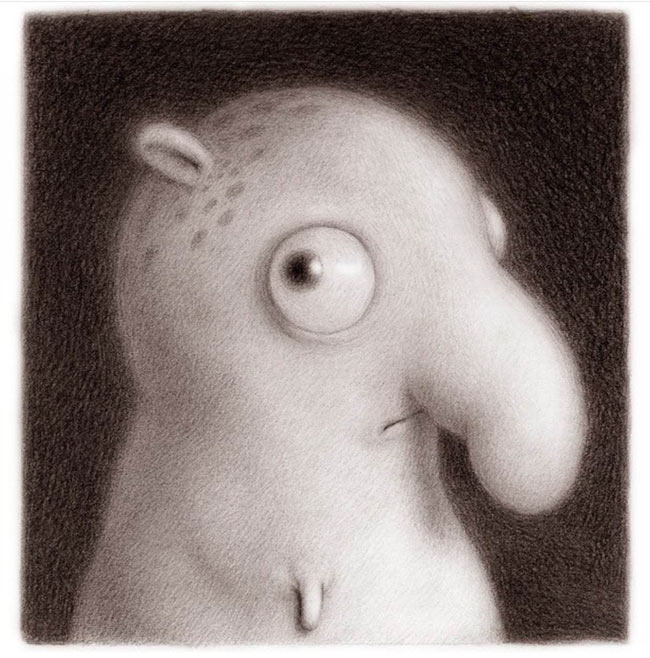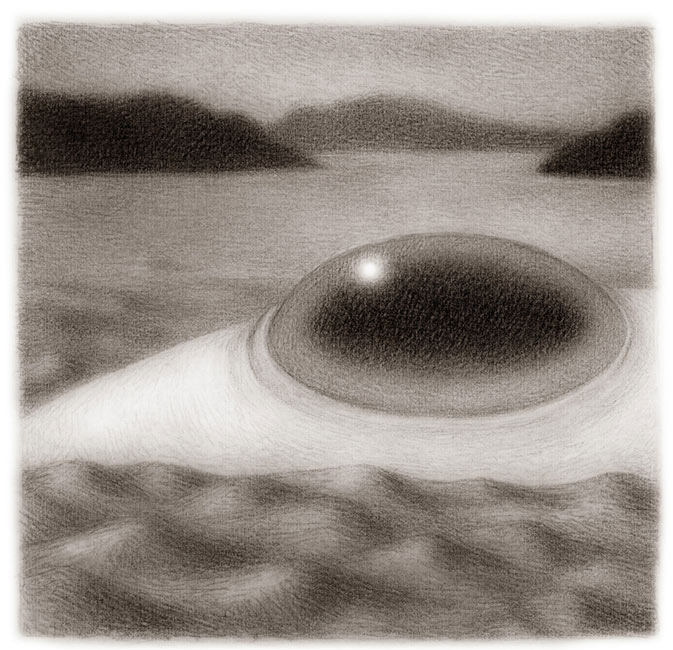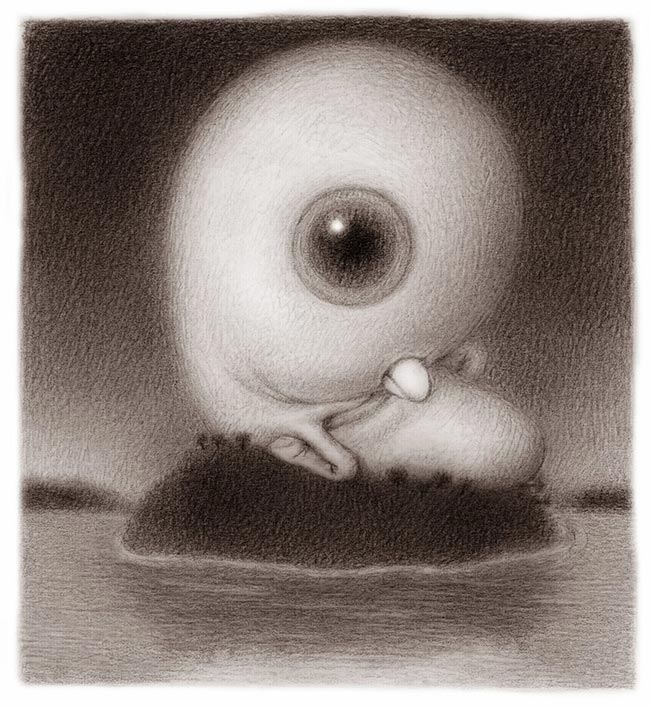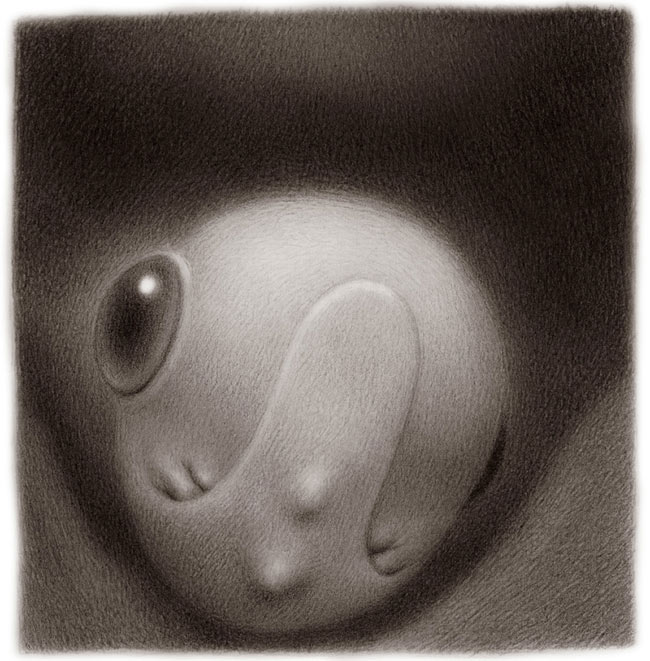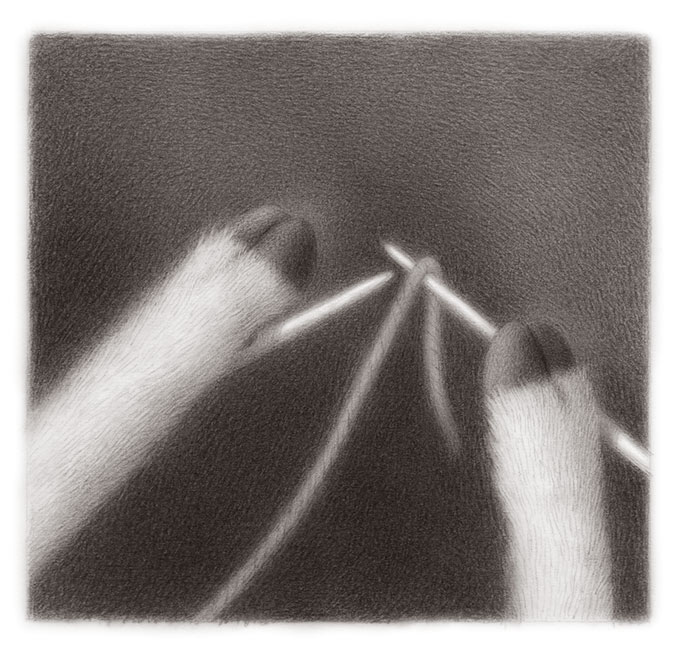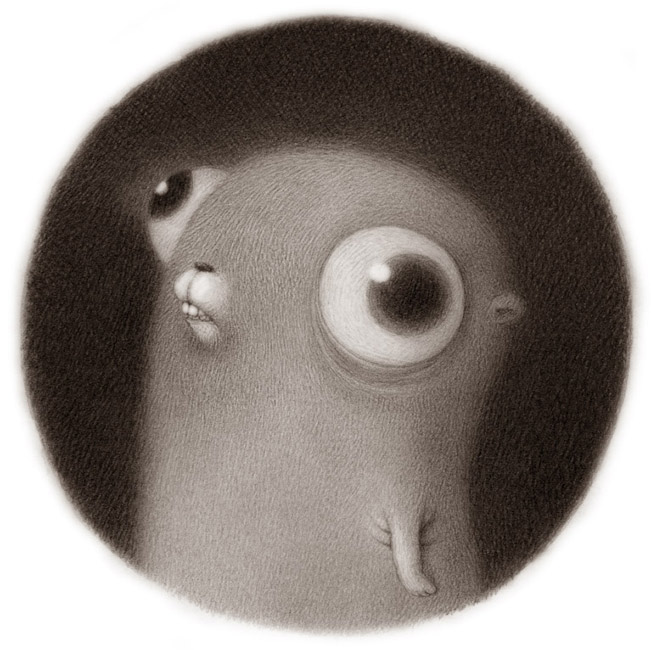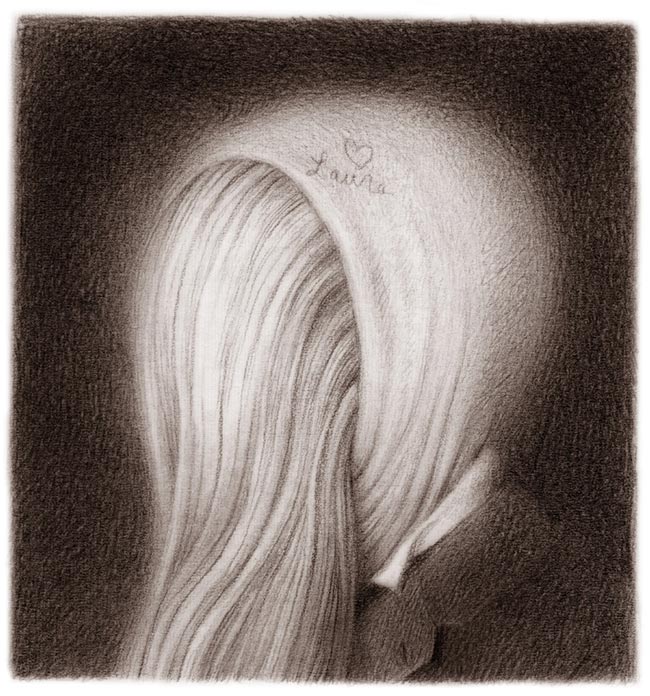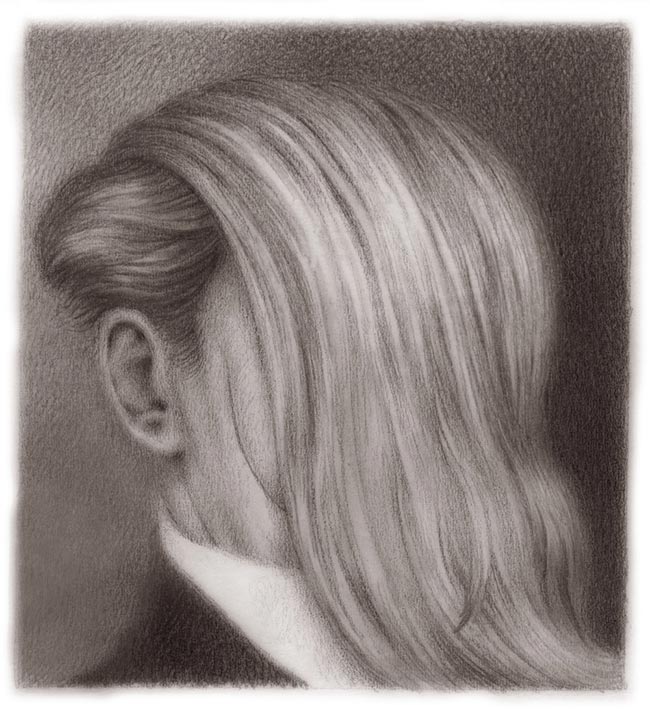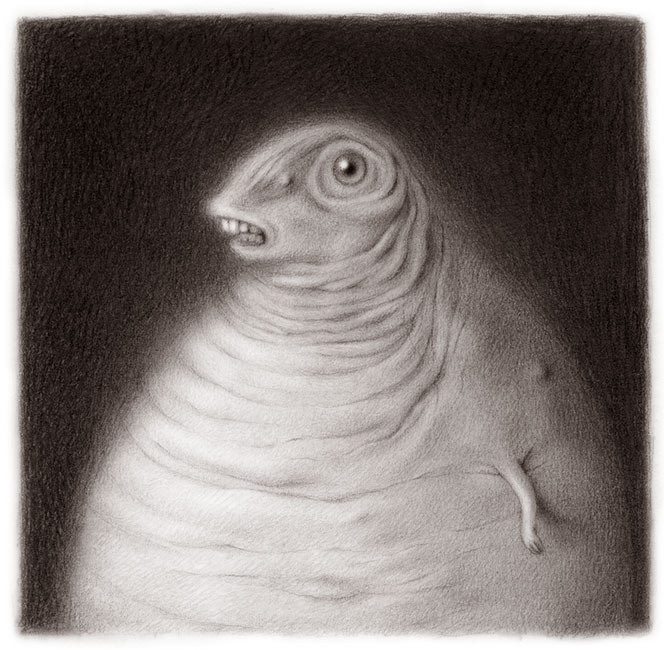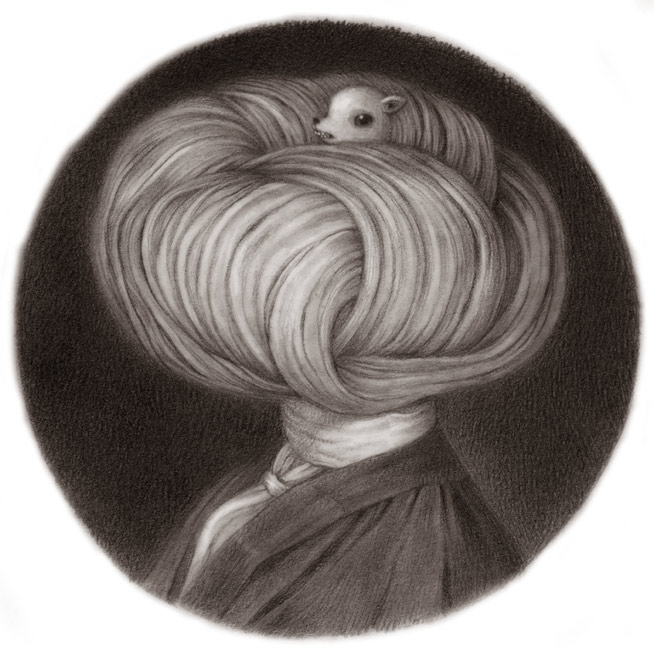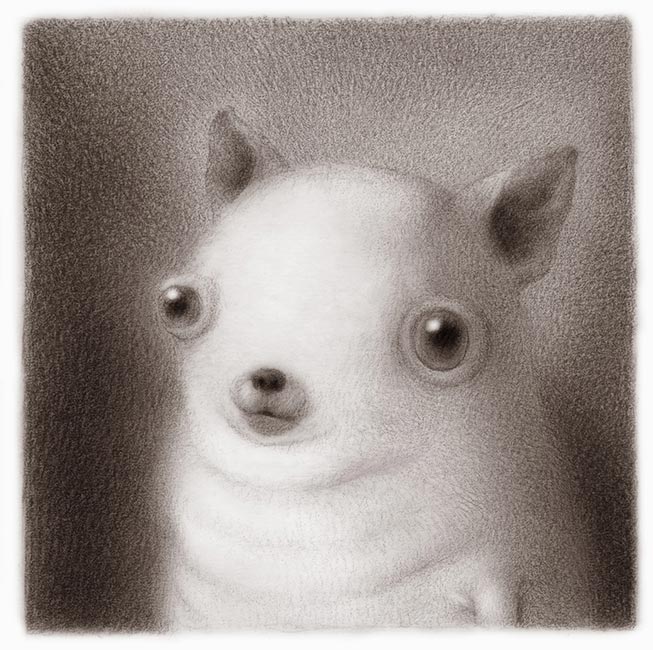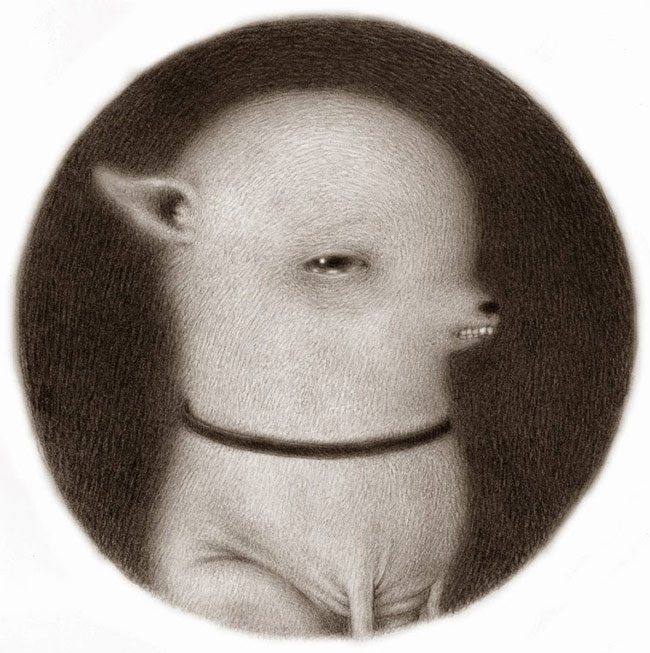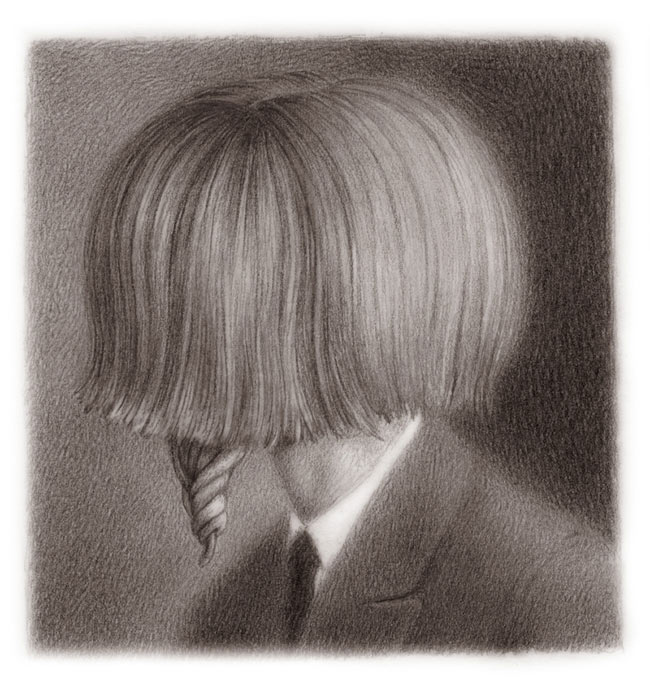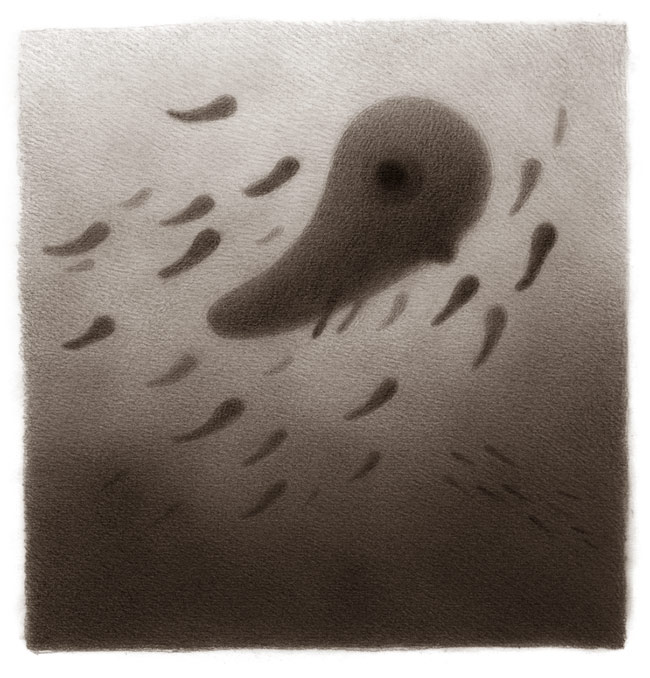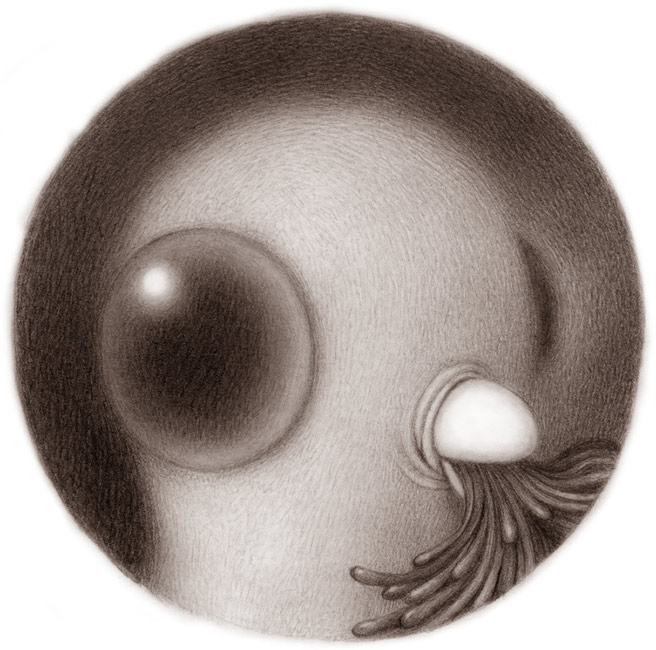Renee French is an American artist, best known as a comics writer and illustrator, who also enthrals audiences as an exhibiting fine artist. The narratives that unfurl from Renee’s mind and onto her paper, span the wide chasm that exists between child friendly fairy tales and the dark gritty regions of adult introspection. Working primarily with extremely fine pointed graphite pencils on miniature pieces of paper, often measuring no more than two or three inches square, French conjures up fuzzy and foreboding images which convey humourous, and at times, disturbing tales. Focusing squarely on creating poignant and emotional portrayals of her characters, French saturates them with feeling, giving realism and depth to even the most fantastical of creatures, whether they be beautiful or less so. And with this last thought in mind, if there is one thing that Renee enjoys reminding us, it is that we shouldn’t always judge a book by it’s cover.
Renee French was born in 1963. She is married to software engineer and author, Rob Pike. They spend time living in both the United States and Australia. When writing books for children Renee often uses the pen name Rainy Dohaney. She has been nominated for a number of the most prestigious awards in the comic book industry, including the Eisner, Ignatz and Harvey awards and she won the Inkpot award at the San Diego Comic-Con in 2007.
WOW x WOW recently had the tremendous pleasure of asking Renee a few probing questions about her work, which she very graciously made the time to answer with truly insightful and engaging responses. Find out what she had to say in the following exclusive interview.
Hi Renee, thanks for agreeing to free up some of your valuable time in order to have this wee chat, we really appreciate it. If you could please start us off by introducing yourself and talking about your background, touching on anything you feel has been relevant to shaping Renee French the artist?
Hi, I’m Renee, and I’m a graphite addict. I grew up in NJ surrounded by corn fields and cows and lots of trees. Yes, they have those in NJ. I’m sure I’m typical in that I was one of those kids who kept drawing and didn’t stop into my adulthood because it was my favourite thing to do. I’ve never figured out how to shift over to paint though, and now I’m trying to do that, finally. Somewhere in my childhood I found a book plate of Hieronymus Bosch’s ‘The Garden of Earthly Delights’, and that was it for me. I don’t know how many hours I stared at it under the covers, but I’d memorised each little scene within the paintings and thought about them all the time. That world was so real to me.
You are an exhibiting artist, although you’re best known as comic book author and illustrator. Do you compartmentalize your creative thoughts, or are all your ideas put into one big pile and you draw from it for whatever project you need to work on at a particular time?
It’s like a big pile of ideas with a river running through it and ideas to the south of the river are OK for kids, and to the north, kids aren’t allowed. The north side is a lot bigger than the south though.
Having produced books for both adults and children, do you have a favourite age group to create for? One would assume that adult subject matter flows from your psyche unfiltered, while the material for kids requires vetting. How do you approach the work you create for children and how do you put yourself in the head space for writing for a younger audience?
I hadn’t thought about my favorite age group before, but I think it’s the age before they can read, when their parents read them stories before bed. At that age, they listen to the words and stare at the drawings for as long as it takes for their parent to finish that page. I know that when I was little I stared like that at drawings in books so hard I memorized the lines that made up the pictures and can remember a lot of them now. Once they learn to read I think many of them concentrate more on the words. I haven’t done a book for that age group for a long time but if I do another children’s picture book it would be for that age group.
Imaginative storytelling is at the heart of your creative process. In your opinion, what are some of the most important ingredients that go into making a successful visual narrative?
I kind of took a left turn at some point and ended up further away from linear narrative and closer to sort of walking around in a made up world. And things in that world need to follow the rules of that world for it to work. One of the trickiest aspects of visual narrative, and you discover it early on when you start telling your stories in drawings, is making a character consistent looking enough for the reader to identify him as that character throughout the story. It’s so much harder to tell a story when you can’t tell who is doing what.
You have previously stated that you are “interested in trying to draw the air between your eye and the subject of a drawing.” Can you expand on this concept for us and give us an insight into what inspired your initial thoughts on the matter?
In college I had a professor called George Sorrels who made beautiful, engaging, tiny paintings of landscapes and human body parts, and one day I showed him a drawing I’d made and he said, “OK, that’s good, now do that again but draw the air between this and that.” I’ve never been successful at doing that, but it doesn’t leave my mind when I’m working on a drawing. The idea that you could draw something that isn’t an object, but instead was nothing, blew my mind back then. It was like trying to draw time, only it was a physical thing, and you could see the effects of it, in the dulling down of the color palette, and value range, and the edges being softer, etc. It took me to being more interested in depth of field in drawings which is a whole different thing. I always come back to thinking about the air, though.
Your art playfully merges cuteness with an equal measure of menace. How do you go about maintaining the fine balancing act that exists between the two?
So much of the time, it just happens that way. I mean, I’ll decide to draw an adorable bunny and go at it directly, no winking, and in the end, it goes sideways. It’s like, what the hell happened? And since during the drawing process, I’m mostly in a space where time slows down, and I’m just feeling the graphite coming off the pencil and onto the paper, and hearing the scritching noises over The Rockford Files, it sneaks up on me. But, when I first started drawing portraits I did a series of girls and rabbits with various ailments and orthotics, to see how far I could deform a face and add medical equipment before the character would turn unattractive. What if a cute bunny had ants covering his face like a mask? If his features were cute would anyone think he was cute even covered in insects? And the answer was, yes, some people thought he was cute, and some people thought he was creepy. I liked that different people could look at the same image and be so polarized. And at this point I still can’t tell which way it’ll go once people see them, and I’m always surprised when it splits down the middle.
Many of your works are created on an incredibly small scale, some of which measure only a couple of inches in width and height. Can you talk about the choices you make regarding the size of your art and some of the challenges you face in the creation of your smaller pieces?
One time I fit an entire exhibition in a greeting card envelope, and flew to Japan with it tucked in my sketchbook. So, there’s that. We travel a lot and I like to work in hotel rooms, so being able to use a book as a drawing table comes in handy. After university I started drawing on a very small scale because it meant I could draw on my bed, or on the couch, and I didn’t have a drawing table. Even when I started drawing comics in the 1990’s it was all on my bed, with a drawing board on my lap. The challenges only started recently with age. I now have to wear crazy strong reading glasses to draw, and the prescription changes a lot more frequently. I draw with a 0.3mm mechanical pencil and sometimes that’s not small enough so I need to sharpen the point on a piece of paper. But that’s all fun.
As someone who suffers from migraines (and in actual fact you have published a book inspired by your headaches, entitled ‘H Day’), how much do they impact your work? Do you work through them, and if so, does the imagery you create become darker or menacing than usual, for instance?
No, I can’t work through them because concentrating your eyes on something makes them worse, but they do effect the imagery after the fact. So many of the images I draw come from times when I’m lying on my back with a cold washcloth in my head. When you can’t move around without throwing up, you have to let go of the real world, and real time, and even though everyone around you is going on with their day, your time has to stop. So in those times I end up using imagery to rescue me. My book, H Day (the version in France is called Céphalées, and it’s silent so that only effects the title) is an attempt to show what it’s like to have a migraine, from the outside and the inside. There’s an ongoing series of drawings on the left hand pages that take you through the pain part of it, showing a character who eventually merges with the bed in a pretty violent way. And then on the right hand pages there’s a story that I’d visualized for years, in order to distract me from the headaches. Even with that entire book, I still go back to that subject. Most of the portraits with things exploding out of the face or the skin warping around the head, are based on the migraines.
How important do you feel your subconscious is to your creative process? Do you have any practices or habits that encourage creative ideas to rise to the surface?
Oh it’s incredibly important. Practices? After a shower (shower is the best place, duh, for ideas) I take a walk to run errands, and that’s where most of the ideas come up. Especially if it’s a boring route that I’ve travelled a zillion times and especially if I don’t run into somebody I know, and I don’t see anyone when I get back home again, and if I manage to sit down to drawing before the phone has rung. Also, the best is going to a bad movie at a theatre and sitting in the very back row with my sketchbook. The sketchbook has notes on mostly things that I’ve been drawing forever like medical body stuff and teeth placement and cute animals.
The human condition is a central focus of your art. Can you talk to us about which aspects of humanity’s search for meaning are the most appealing to you and which ones you frequently return to exploring in your work?
When I was little, around the time I became fascinated with death I decided that the human body couldn’t be trusted to work the way it should to survive. It wasn’t just a realisation that we all die, it was that bodies were so unreliable, and the more I looked at the medical books that were in our house, (we had a lot of them), the less I believed that the human body could possibly keep working properly, and that even if it seemed to be working there had to be some secret broken bit inside that would go at any time. I worried about it way too much. Like, expecting that my breathing would stop suddenly, just because, things break. So, that stuff ends up in my work for sure. We’re so fragile, and so resilient at the same time.
What is your relationship with art history? Do you feel that it’s important for an artist to have an understanding of what has gone before them?
I wish I’d studied more art history than I have, but even the little I’ve done has been valuable. You would NOT want me on your art history quiz night team. There’s a book I love that I wish I’d read as a student called ‘The Journal of Eugene Delacroix’ that I’ve read over and over and have learned so much from it. I’d recommend it to anyone who studies or makes art.
If you could own one piece of art from any of the world’s collections what would it be and why?
It would have to be the Jean-Auguste-Dominique Ingres painting at The Frick in NYC, Comtesse d’Haussonville. Her skin is insanely glowy. It’s as if you can see the light penetrating through her skin into the layers beneath that, and bouncing off her blood vessels and out again. All this reflected color. But it’s the weird proportions and the made up anatomy, that makes it feel truer than truth. The proportions of her face and arm are strange, and then she has an arm that sort of grows out of the front of her dress, but somehow it feels truer than a photograph.
What’s next for Renee French?
There’s the exhibition at La Luz De Jesus opening October 2nd which is a four person feature show. I’ll have 30 drawings up and the other artists are: Alessia Iannetti, Zoe Laccei and Aaron Bo Heimlich. Then it’s back to working on a book for Koyama Press called Horatio. And I’ve been trying to paint, so maybe more of that.

